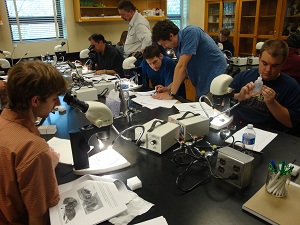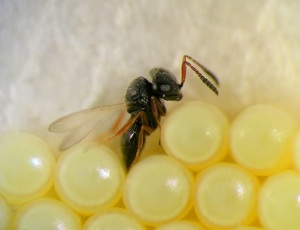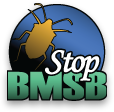SCRI Team Provides Training on Parasitoid Identification
 |
|
Researchers participate in a hands-on exercise to identify natural enemies of brown marmorated stink bug during an April 2012 workshop in Delaware. Source: K. Hoelmer, USDA Agricultural Research Service |
Researchers suspect that our best defense against the brown marmorated stink bug (BMSB) could be a large group of parasitic wasps that would serve as natural control agents against the invasive pest. At a recent workshop in Newark, Delaware, entomologists shared critical information about native parasitoids that attack stink bugs in North America.
Kim Hoelmer, a USDA scientist who helped organize the event, is particularly interested in a group of tiny parasitic wasps that are very specialized in their choice of a host insect. Some types of parasitic wasps attack and develop inside spiders, beetles, or aphids; other groups are known to attack stink bugs.
The 24 researchers and graduate students who attended the workshop are expanding what is known about natural enemies of BMSB. They learned to distinguish the different kinds of natural enemies of BMSB so they would know whether parasitoids they encountered in the field were new or already reported elsewhere.
Each participant received a master key to identify native parasitoids of BMSB, which presented current observations previously scattered across different scientific journals. They practiced identification with unlabeled specimens—all known parasitoids of BMSB—and some brought unknown specimens they had collected in the field.
The parasitic wasp is very tiny, growing inside a host BMSB egg, emerging at maturity at 1.5 mm. Its small size presents challenges for researchers trying to study it, so workshop leaders shared special techniques for handling and mounting such small specimens. For example, Hoelmer explained, quality of microscope optics is an issue if you need to see whether or not a ridge on a part of the body is interrupted or runs from one side of the body to the other.
 |
|
An adult Trissolcus basalis female attacks an egg mass of the stink bug species Nezara viridula, similar in appearance to the eggs of brown marmorated stink bug. Several related Trissolcus species attack BMSB in its native range in Asia, and in North America. Source: M. Roche, USDA Agricultural Research Service European Biological Control Laboratory |
Armed with this information, researchers can use their knowledge to recognize locally important natural enemies of BMSB and to monitor the levels of parasitism in the field. Both are important parts of a strategy to control the invasive insect using natural means.
“In a day and a half we presented tools and materials to help a keenly interested group of researchers identify natural enemies of BMSB,” Hoelmer said. “I was amazed and astonished by the level of interest.”
The workshop, which Hoelmer led with colleagues Christine Dieckhoff, Kathy Tatman, and Matt Buffington of USDA’s Agricultural Research Service, was part of a broader project entitled “Biology, Ecology, and Management of Brown Marmorated Stink Bug” that has been funded through the Specialty Crop Research Initiative. The University of Delaware let organizers use a teaching laboratory that was perfect for this event.
“We were expecting maybe 8 to 10 people would attend,” Hoelmer said, “but we found there was much greater interest. We had to turn away some due to lack of seats.” The group may plan another workshop to meet demand. To learn more, or to receive information about future workshops, contact Christine Dieckhoff.
— by CHRIS GONZALES
StopBMSB.org provides information about our team's efforts to control brown marmorated stink bug (BMSB), through funds provided by the USDA's Specialty Crop Research Initiative. If republishing our news, please acknowledge the source ("From StopBMSB.org") along with a link to our website.
